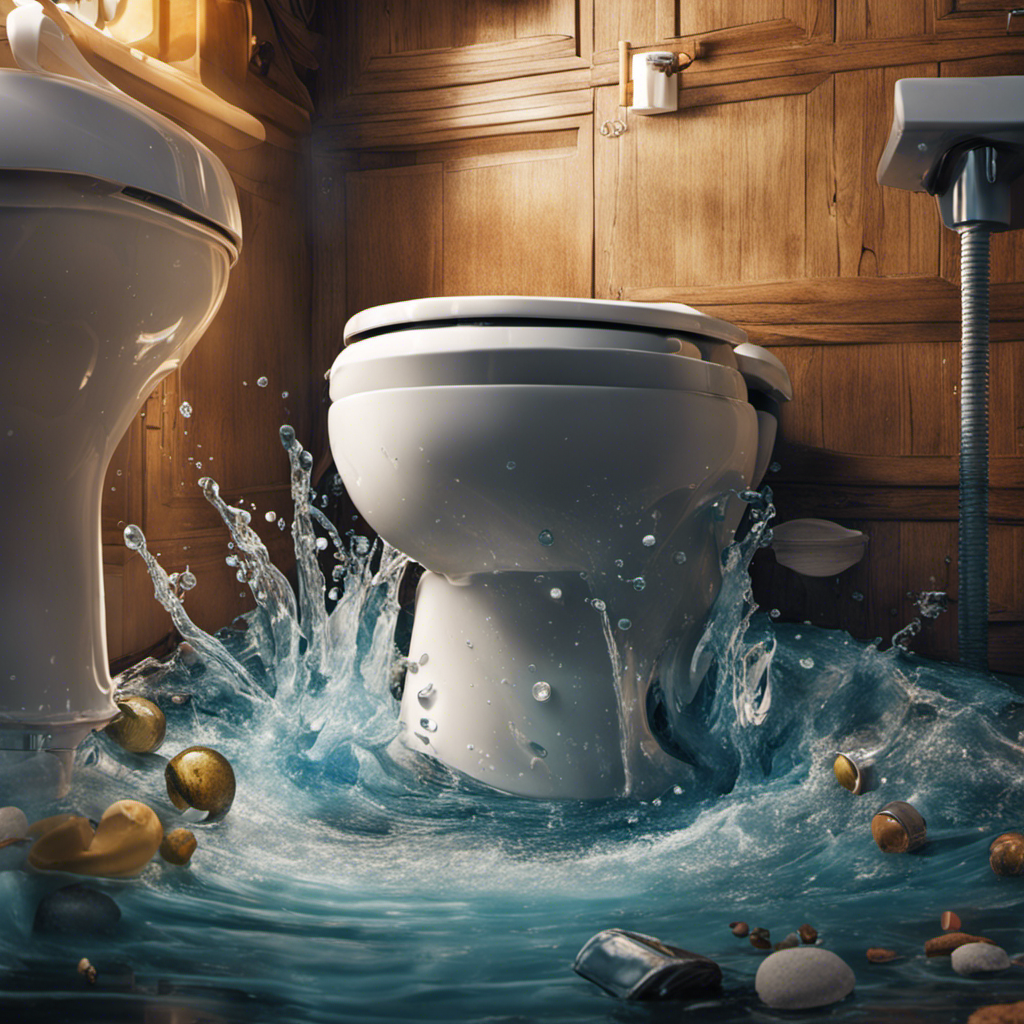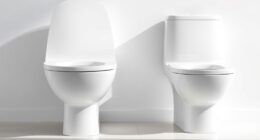Have you ever wondered why your toilet doesn’t flush properly? Well, fret no more! In this article, we will explore the common reasons for a weak toilet flush and provide you with practical solutions.
From clogged toilet drains to plumbing issues, we will troubleshoot the problem step by step.
And if all else fails, we’ll even discuss upgrading your toilet for better flushing performance.
Say goodbye to toilet troubles and hello to a smoothly functioning bathroom!
Key Takeaways
- Clogged or partially blocked trapway can restrict water flow and reduce flushing power.
- Low water pressure can contribute to a weak flush.
- Faulty flapper mechanism can lead to constant running.
- Upgrading to a newer toilet model or a pressure-assisted toilet can improve flushing performance.
Common Reasons for a Weak Toilet Flush
One common reason for a weak toilet flush is a clogged or partially blocked trapway. The trapway is the curved passage in the toilet that connects the bowl to the drainpipe. When it becomes clogged with debris or mineral buildup, it restricts the flow of water and reduces the flushing power.
To check if the trapway is the issue, start by inspecting the toilet tank. Ensure that the water level is set correctly and that the flapper is opening fully during flushing. If the tank is functioning properly, then the problem lies within the trapway.
To address this, you can try using a toilet auger or a plunger to clear the blockage. Additionally, low water pressure can also contribute to a weak flush. If you suspect this is the case, you may need to consult a plumber to assess and resolve the issue.
Clogged Toilet Drain: Causes and Solutions
Having a clogged toilet drain can be caused by various factors, but there are solutions available to fix the issue.
When your toilet drain is clogged, it can disrupt the normal functioning of the toilet flushing mechanism. The flushing mechanism relies on a combination of water pressure and gravity to remove waste from the bowl and into the drain. However, if the drain is clogged, this process can be hindered.
To unclog a toilet drain, there are several techniques you can try. One common method is using a plunger to create suction and dislodge the blockage. Another option is using a toilet auger, which is a long, flexible tool designed to reach and remove clogs. Additionally, chemical drain cleaners can also be effective in breaking down the clog.
Plumbing Issues That Affect Toilet Flushing
When a clogged toilet drain occurs, it can lead to issues with the normal flushing process. To ensure proper toilet bowl maintenance and prevent water pressure problems, it is important to address plumbing issues that affect toilet flushing. Here is a table highlighting some common plumbing issues and their impact on flushing:
| Plumbing Issue | Impact on Flushing |
|---|---|
| Partial clog | Weak flush |
| Complete clog | No flush |
| Low water pressure | Incomplete flush |
| Faulty flapper mechanism | Constant running |
To maintain a properly functioning toilet, regular maintenance is crucial. This includes avoiding flushing items that can cause clogs, such as paper towels or feminine hygiene products. Additionally, checking water pressure regularly and fixing any leaks or faulty mechanisms can help ensure a consistent and efficient flush every time.
How to Troubleshoot a Toilet That Won’t Flush
To troubleshoot a toilet that won’t flush, start by checking the water level in the tank. Make sure it is at the appropriate level, which is usually marked on the inside of the tank. If the water level is low, adjust the fill valve to increase the water level.
If the water level is fine, the issue may lie with the flush mechanism. Here are some steps to help you fix the toilet flush mechanism:
- Inspect the chain connecting the flush handle to the flapper valve. Make sure it is properly connected and not too loose or tight.
- Check the flapper valve for any damage or debris. Clean or replace it if necessary.
- Examine the flush valve seal for any signs of wear or damage. Replace it if needed.
Upgrading Your Toilet for Better Flushing Performance
If you want to improve the flushing performance of your toilet, consider upgrading to a newer model. Upgrading your toilet can help ensure a more efficient and powerful flush, addressing issues such as weak flushing or clogs.
When choosing a new toilet, look for features that promote better flushing performance. One important component to consider is the toilet flapper. This rubber valve controls the release of water from the tank into the bowl during flushing. Opt for a toilet with a high-quality flapper that creates a strong and consistent seal, preventing water from leaking out and reducing flushing power.
Additionally, pay attention to the water pressure in your home. Low water pressure can hinder flushing performance, so consider installing a pressure-assisted toilet that uses compressed air to improve flushing power.
Upgrading your toilet can make a significant difference in its flushing performance, ensuring a more efficient and hassle-free experience.
Conclusion
In conclusion, if your toilet won’t flush, don’t panic! There are several common causes for this frustrating issue, such as a clogged drain or plumbing problems.
By troubleshooting the problem and considering an upgrade to your toilet, you can improve its flushing performance. Remember, a reliable flush is crucial for a clean and comfortable bathroom experience.
So, take charge of your toilet troubles today and transform your lavatory into a pristine paradise!










